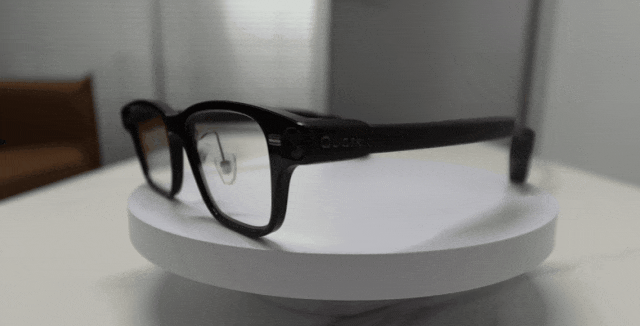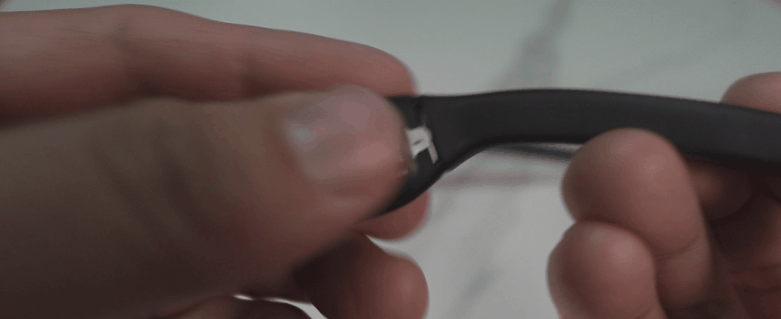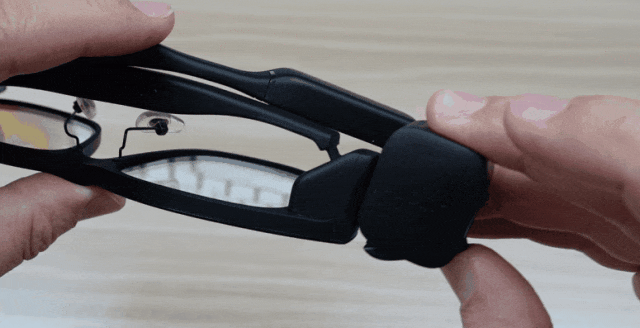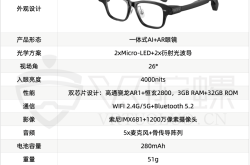Alibaba's Smart Glasses Venture: Does It Have a Future? A Hands-On Review of the New Quark AI Glasses, Covering Object Recognition, Payment, Photography, Battery Life, and More
![]() 11/28 2025
11/28 2025
![]() 535
535
When indulging in sci-fi movies, I've always been captivated by the sleek smart glasses worn by the protagonists. Who would have guessed that this year, AI glasses would experience a sudden surge in popularity, with tech firms of all sizes jumping into the fray? Recently, I had the chance to personally test out the highly anticipated Quark AI Glasses S1.
As Alibaba's inaugural self-developed AI glasses, expectations are running high. But are they truly as impressive as they seem, or are they just a flashy display? Can they avoid the fate of becoming another AI product that ends up gathering dust after purchase? After using them extensively and delving deep into their features, I'm here to share my candid thoughts.
Appearance and Wearability: 'Invisible' Like Everyday Glasses
Upon opening the box of the Quark AI Glasses, I was pleasantly surprised. They bore a striking resemblance to the regular glasses I usually sport, devoid of the typical bulkiness associated with electronic devices. The temples and frame are incredibly slender, making it difficult to discern their 'special identity' at first glance.

Image Source: VRAR Planet Hands-On
The first impression is one of lightness. As someone who doesn't typically wear glasses, I'm particularly sensitive to anything perched on my nose. Quark has excelled in this regard. The nose pads and temples are meticulously designed to evenly distribute the weight. I wore them for several consecutive hours without developing those two unsightly red marks on my nose.
I previously tried out the Meta and Ray-Ban collaboration glasses, and the biggest annoyance was their tendency to slide down constantly, necessitating frequent adjustments. Well, their nose pads were tailored for Europeans with high nose bridges, which is quite inconvenient for someone like me with a typical Asian flat nose. In contrast, the Quark glasses stay firmly in place, offering a snug fit and largely eliminating the 'sliding down' issue.
Core Functions: A Personal AI Assistant That Gets You
Of course, appearance and comfort are just the tip of the iceberg. The real test lies in what these glasses can actually do for you.
Visual Search: Instant Recognition and Understanding
The most astonishing feature for me was undoubtedly the AI camera function, which truly delivers an 'instant recognition and understanding' experience.
For instance, standing in front of a makeup counter overwhelmed by a plethora of color options, I simply whispered, 'Quark, what's the brand and price of this lipstick?' Within two seconds, the product information and price appeared right before my eyes on the lens, all without the need to pull out my phone—it felt incredibly natural.
If I spot someone wearing nice clothes outside, there's no need to sneakily take a photo to search for similar items anymore. I just ask, 'Quark, how much is this outfit?' The model number and price instantly pop up, transforming it into a 'walking recommendation and de-recommendation tool'.

Image Source: VRAR Planet
Moreover, its recognition capabilities are incredibly detailed and accurate. This is made possible by Qwen's powerful multimodal large model and Quark's billion-scale image retrieval capabilities.
Honestly, given its current level of maturity, the Quark AI Glasses are not just a concept product; they're genuinely useful. It's evident that Alibaba has made significant technical preparations for this product line.
Additionally, whether under bright outdoor sunlight or indoor lighting, the information displayed on the lens automatically adjusts its brightness for clear visibility without obstructing your view. At night, it switches to high-contrast fonts that are gentle on the eyes.
Seamless Integration with the Alibaba Ecosystem: Born with a 'Golden Spoon'
One advantage the Quark AI Glasses have over other products is that they're born with a 'golden spoon'—they're deeply integrated into the entire Alibaba ecosystem.
While cycling, the navigation arrows from Gaode Maps are projected right onto the road ahead; while shopping, Taobao's price recognition turns you into a 'human product identification app'; when making payments, using Alipay's 'glance to pay' feels like something straight out of a sci-fi movie; when traveling for business, trip reminders from Fliggy and Alibaba Travel pop up on time to ensure you don't miss your flight.

Image Source: VRAR Planet Hands-On
During my commute or spare moments, I use them to listen to podcasts and music. The sound is crystal clear, the quality is excellent, and there's decent noise isolation, so you don't disturb others nearby.
If I encounter foreign menus or documents I can't read, or need to communicate briefly with foreign friends, a shout of 'Quark, real-time translation' brings up Chinese subtitles right before my eyes—it's incredibly convenient.
This experience of being supported by an entire ecosystem is indeed hard to match for other standalone AI glasses.
Its voice interaction is also well-executed, truly 'understanding human language'.
For example, you can simply say, 'Quark, call my mom,' and it will dial out directly. You don't even need to touch your phone to answer calls. More impressively, it supports multi-round conversations and complex instructions. Unlike some smart assistants where you have to call their name every time, you can string together several requests at once. Its built-in large model control center understands these complex needs and continues the conversation naturally, making interactions much smoother.

Image Source: VRAR Planet Hands-On
Photography: A 'Killer Feature' That Perfects Night Photography
Capturing life's moments is a timeless pursuit, and photography is undoubtedly one of the most frequent and core application scenarios for AI glasses.
In this regard, Quark has invested significant effort into the Quark AI Glasses, particularly in their night photography capabilities, which are polished to near perfection, rivaling even some flagship smartphones. This can undoubtedly be called its biggest 'killer feature'.

Quark AI Glasses Night Photography, Image Source: VRAR Planet
Apparently, this is powered by a Quark patent called the 'SuperRaw Low-Light Processing Algorithm'. It's a system that links the camera sensors on the glasses with the computational photography capabilities of a smartphone. The impressive part is that it's the first time the mature 'Raw Domain Noise Reduction' technology, which has been refined in the smartphone industry for years, has been successfully applied to AI glasses—a decision that seemed incredibly bold, even 'crazy,' at the time.
Simply put, it fuses and intelligently reduces noise across multiple photos at the most original (raw) data stage (RAW domain). Not only that, but Quark has also incorporated gyroscope motion compensation to in real-time correct minor hand tremors during shooting, reducing blurry photos. The end result is that even if you're shooting while walking, it delivers outstanding image stabilization.

Cycling Night Photography, Image Source: VRAR Planet
Battery Life and Privacy: Clever Solutions to Two Major Pain Points
Battery Swap Design: Say Goodbye to Battery Anxiety
Battery life is arguably the Achilles' heel of all smart glasses. Quark's solution is quite ingenious—instead of piling on batteries, they've adopted a 'battery swap' approach. The temples themselves are batteries, utilizing hot-swappable technology. You can simply 'click' out the depleted temple and 'click' in a fully charged one, just like changing a pen refill, all within seconds.

Image Source: VRAR Planet Hands-On
Don't underestimate this 'click-in, click-out' design; it's technically quite sophisticated. It requires fitting a reliable physical structure and high-speed data channel into such a thin temple while ensuring a perfect fit every time without any errors.
Apparently, Quark AI Glasses have named this detachable temple battery the MiniMag Backup Battery, which also comes with a matching MiniBag Battery Swap Case. This ultra-compact Mini battery design is actually more suitable for lightweight travel than a glasses case, supporting all-day use.
Currently, the official offers several 'recharge' methods, covering almost all scenarios:
Battery Swap Case: The main method, as convenient as using a wireless earbud case.
Charging Clip: For emergency top-ups, presumably quite quick.
Glasses Case Charging: Charge while storing, suitable for daily habits.
Power Cable Charging: The most traditional but also the most reliable wired option.

Image Source: VRAR Planet Hands-On
Privacy Protection: No Secret Photography Allowed!
When many people hear that AI glasses can take photos, their first reaction is, 'Will I be secretly photographed?' Quark has done a commendable job in this regard.
Firstly, it provides clear status indicators: a flashing white light when taking photos and a constant white light when recording video, alerting those around you that you're currently capturing images.
Regarding screen light leakage, I specifically tested it. From a normal conversation perspective, others cannot see the content on your lens at all.
Actual Experience: Can It Really Reduce My Phone Usage?
After using them intensively for several days, my answer is: yes, especially in certain scenarios.
For example, while navigating, I don't need to look down at my phone anymore; a quick glance upward shows the arrows and road names floating before my eyes. If I encounter unfamiliar English, I don't need to open a translation app; a simple question provides real-time translation. When shopping and spotting a product I like, the price and model number appear instantly—it's incredibly convenient.
However, there are definitely areas that require adaptation. The most obvious is using voice in quiet environments—like a library or meeting room. Even speaking softly can feel a bit awkward. This part might take some time to get used to this new 'talking to myself' interaction.
So, who are they most suitable for? I think these groups might particularly like them:
Frequent business travelers: Navigation, trip reminders, and translation are all very useful;
Tech enthusiasts who love trying new things;
And anyone tired of constantly pulling out their phone, seeking a more efficient life.
The transition from 'phone always in hand' to 'glasses always in sight' might still take time. But if you're looking for an AI glasses option that's not overly geeky, naturally integrates into daily life, and genuinely helps reduce your phone usage, the Quark AI Glasses are worth your attention. They might not be perfect yet, but on the journey to 'making AI glasses part of everyday life,' they've already come further than most.
Text by Vivi
All hands-on photography content in the article is sourced from VRAR Planet








